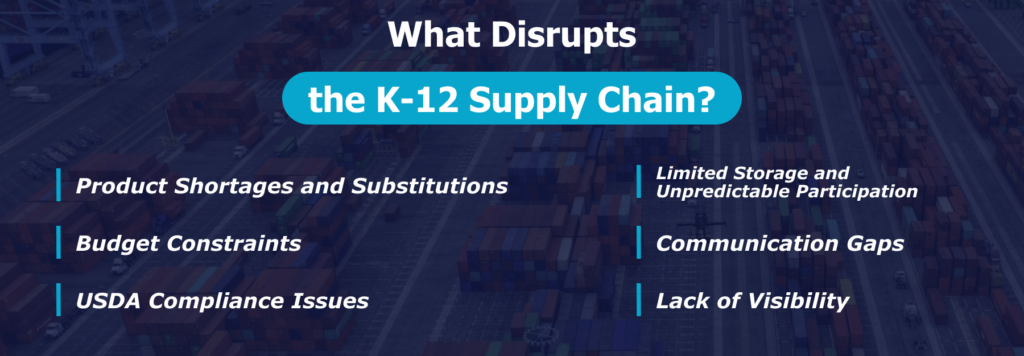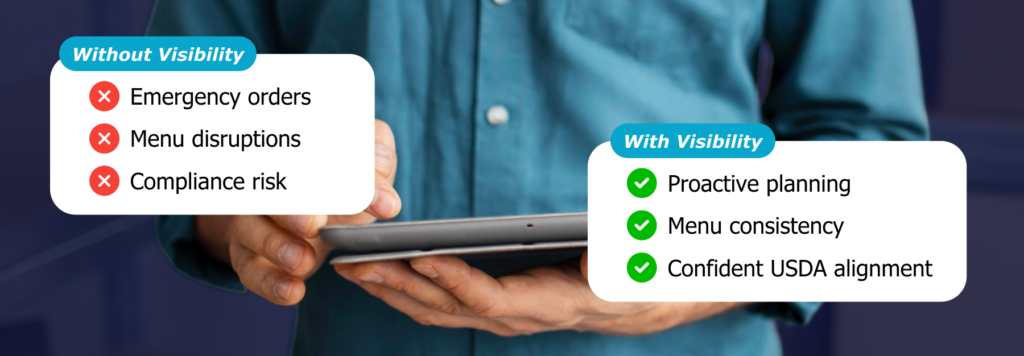
Every day, school nutrition teams across the country serve millions of meals to students—they support student focus, health, and academic performance. But what often goes unseen is the complex supply chain that makes those meals possible. From fluctuating product availability to evolving regulations and tight budget constraints, K-12 foodservice programs operate under a unique set of challenges. Understanding the supply chain’s role—and the risks when it breaks down—is essential for keeping meal programs running smoothly and students well-fed.
The Complexity of the K-12 Supply Chain
K-12 school nutrition programs face operational demands that differ significantly from those in commercial foodservice. Most public schools participate in federally funded programs like the National School Lunch Program (NSLP) and School Breakfast Program (SBP), which require strict adherence to USDA nutritional standards. These standards dictate portion sizes, calorie counts, sodium limits, and more—all of which vary based on student age groups and meal types.
Compliance isn’t optional—it’s essential for funding. That means even minor product substitutions or shortages can ripple into major problems. When you add in factors like limited storage, unpredictable student participation, and budgetary constraints, it’s easy to see why K-12 supply chains require precision, reliability, and flexibility.

Why Supply Chain Visibility Matters
When school nutrition operators lack insight into what’s happening across their supply chain, it creates a ripple effect that can disrupt everything from compliance to cost control. Without clear visibility, they risk:
- Menu substitutions that can disrupt USDA compliance or lead to student dissatisfaction.
- Increased costs due to last-minute or emergency orders.
- Wasted time manually tracking down supply issues or product changes.
- Limited forecasting ability when product usage and availability aren’t clearly tracked.
- Budget overages caused by unexpected pricing fluctuations or missed opportunities to pivot.

On the other hand, when operators have visibility, they gain something powerful: control. Visibility into product availability, pricing, and vendor performance allows K-12 programs to make informed, proactive decisions—rather than reactive ones. They can adjust menus in advance if products are unavailable, keep purchasing aligned with budget targets, and communicate more effectively with distributors and manufacturers. It’s not just about seeing more—it’s about seeing what matters, when it matters, and using that insight to support compliance, participation, and efficiency.
Strengthening Resilience Through Planning and Collaboration
In K-12 foodservice, a resilient supply chain isn’t just one that survives disruptions—it’s one that’s built to anticipate, absorb, and adapt to them. That kind of resilience doesn’t happen by accident; it’s the result of proactive planning, strategic partnerships, and continuous communication. That means:
- Building strong relationships with distributors and manufacturers to align on expectations and maintain open lines of communication.
- Diversifying suppliers when possible to reduce reliance on any one vendor or product source.
- Leveraging forecasting tools and historical data to anticipate demand and avoid last-minute surprises.
- Sharing feedback up the chain when products or performance fall short, creating opportunities for improvement.
When operators and supply chain partners work collaboratively, small challenges can be addressed before they escalate—minimizing disruptions and keeping school meals on track.
Technology in Modern School Nutrition Programs
While many K-12 programs still rely on spreadsheets and manual processes, technology is changing how districts manage their operations. Digital tools can help streamline:
- Procurement tracking
- Inventory and demand planning
- Compliance documentation
- Communication between partners
With limited staffing and increasing responsibilities, automation and data-driven decisions are becoming more important than ever.
K-12 foodservice teams do more than just serve meals—they fuel student learning and wellbeing. A strong, stable supply chain makes it possible to do that reliably, day in and day out. Whether through better planning, stronger partnerships, or smarter tools, investing time into understanding and strengthening the supply chain is one of the most strategic moves a school nutrition program can make.
Feeding students isn’t just a daily task—it’s a mission. And behind that mission is a supply chain that must be strong, responsive, and ready for anything. For school nutrition professionals, investing in supply chain visibility, collaboration, and forward-thinking strategies is about more than operations—it’s about ensuring every student gets the meal they need to thrive.
Tools like ArrowStream support K-12 programs by providing the supply chain intelligence and connectivity needed to make smarter decisions, strengthen vendor partnerships, and keep meals moving—no matter what challenges arise. That’s why customers like Taher, Cincinnati Public Schools, and AVI Foodsystems trust ArrowStream to help manage their K-12 foodservice supply chains.
With the right partner in place, K-12 operators can focus on what matters most: nourishing students, every single day. Click here to contact us today and learn more.